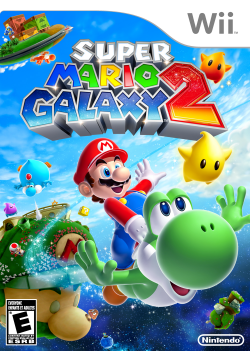 Super Mario Galaxy 2 (Nintendo Wii)
Super Mario Galaxy 2 (Nintendo Wii)
User Review
Product Information:
- Release Date (NA): May 23, 2010
- Release Date (EU): June 11, 2010
- Release Date (JP): May 27, 2010
- Publisher: Nintendo.
- Developer: Nintendo EAD Tokyo.
- Genres: Platformer.
Game Features:
Review Approach:
After the critical and commercial success that was Super Mario Galaxy back in 2007, a natural question suddenly popped up: What comes next? Galaxy was such a creative project that the developers still had many concepts and ideas left for the space setting. So they decided to create an expansion to the game, code-named: "Super Mario Galaxy More" But the concepts were just too plentiful and worthwhile for such a small project. So the developers instead decided to do something unique, creating a direct sequel to one of 2007's most beloved games.
Released three years after the first game, Super Mario Galaxy 2 went on to receive critical praise. And it is still highly regarded amongst the Mario fanbase, just like its predecessor. With some people even considering Galaxy 2 to be even better than the first game. Super Mario Galaxy is already one of my favorite games of all time, so how does Super Mario Galaxy 2 compare to the first Galaxy? And how well does it hold up ten years after its initial release? Let's take a look at Super Mario Galaxy 2.
The plot of the game is remarkably similar to the first game, as well as being somehow even more simplified. We are once again at the Star Festival, and Peach invites Mario to her castle to celebrate the festivities. But along the way, Mario meets a lost Baby Luma who quickly takes a liking to the Italian plumber's warm hat. As a result, Mario gains the spin ability from the previous game, and also makes a new friend! After the little meet-up, Mario arrives at the castle only to discover Bowser already at the scene. Except this time, the Koopa King is now a gigantic beast. Bowser then makes his escape, kidnapping Princess Peach once again. Mario then meets some Lumas at the castle, who recognize the Baby Luma that Mario met earlier as the young master. The yellow Lumas then quickly transform into Launch Stars, allowing Mario to pursue Bowser.
After defeating a Baby Dino Piranha and obtaining a Power Star, Mario finds himself on a stranded planet with only a few Lumas to be found in it. Mario then meets the leader of the Lumas, Lubba. Lubba explains to Mario that Bowser stole the power stars that were responsible for powering his ship. Lubba then offers Mario his help in defeating Bowser in exchange for recovering the Power Stars. Mario agrees, with Lubba then using the Power Star to transform the Planet into a ship that resembles Mario's face. Now it is up to Mario to collect the power stars, confront Bowser, and rescue the Princess.
On the whole, this is the standard Mario plot as we know it. But as I mentioned above, it is also simplified from Super Mario Galaxy's already simplified story. It lacks the epic scope that the first game had, feeling more like a standard Mario affair, which is a step backward from the fantastic execution of the first game. But this is a Mario game, and the plot was never a focus in the first place. So while this plot gets the job done, it is a little bit disappointing that the second game fails to create the same compelling atmosphere of the first game.
Thankfully, Super Mario Galaxy 2 still has the fantastic graphics and audio quality of the first game. The game's visuals, on the whole, are mostly unchanged from the first game. But with a clear difference in the overall aesthetic. While Super Mario Galaxy had its fair share of colorful levels, most of the game features a darker color palette to convey the outer space setting. Super Mario Galaxy 2, in contrast, has a greater variety of level aesthetics that put a greater emphasis on brighter colors. This change results in Super Mario Galaxy 2 feeling even more like a regular Mario game. With the blue skies, in particular, becoming a common sight. Whether or not this change was an improvement or not is a matter of preference. But this change allows Super Mario Galaxy 2 to stand out from its predecessor. The music also takes a different direction compared to the first game, while still being of similar quality. Super Mario Galaxy's soundtrack emphasized the epic scope of the outer space setting. Super Mario Galaxy 2's soundtrack instead decides to tackle a more energetic direction that complements the changes made to the visuals. Mahito Yokota once again returns as the composer for the game, and he brings the same excellent quality as before. Some of the standouts include Throwback Galaxy, Melty Monster Galaxy, Cloudy Court Galaxy, Slider, and the Main Theme.
Seeing as this is a direct sequel, Super Mario Galaxy 2's gameplay has much in common with the previous game. The controls, for example, are the same as before. So if you enjoyed how Galaxy controlled, then Galaxy 2 will offer the same experience as before. The power-ups are also very similar to before. Most of the power-ups from the previous game make their return, and they are just as underwhelming as they were in the first game. The Ice Flower and the Red Star do not return, but in their place, some new power-ups make their debut. The Rock Mushroom, the Spin Drill, and the Cloud Flower. The Rock Mushroom allows Mario to become a rolling ball by spinning. The ball can be hard to control due to how fast it can get, and it does not get any use besides specific stars that take advantage of it. The Spin Drill is also sparsely used. To use the drill, do a spin on certain surfaces, which will make Mario drill under the surface. These two items are not items that make your journey easier. They are used to offer unique challenges for the player instead. In that regard, they succeed. But the Cloud Flower is by far the best power-up in the game. By spinning, Mario creates a cloud platform that stays for a limited time. You have three cloud platforms that can you can refuel by grabbing another Cloud Flower. Mario also gains a floatier jump. These two factors are natural expansions to Mario's move set and allow for many platforming opportunities, similar to what F.L.U.D.D accomplished in Super Mario Sunshine. The Cloud Flower alone makes Super Mario Galaxy 2's power-ups an improvement over the first game, but that is not saying much sadly. So the power-ups, while slightly better, are not that much better than the first game.
But that's where the similarities between the two games end since Super Mario Galaxy 2 makes a host of additions to the core gameplay, while also changing many aspects to streamline the experience. Let's start with the changes made to the first game. While Super Mario Galaxy's hub world was great, Super Mario Galaxy 2 decides to scrap it in favor of a simple world map. The world is very similar to the ones found in the 2D Mario games, with some forks along the way that allow for limited non-linear progression. The Hungry Lumas are also now found on specific spots on the world map, but now they also demand a higher amount of star bits. This change does make grinding for star bits a more common occurrence, however, but they are some stars that can allow for some easing farming spots. While ideally, there wouldn't be any grinding at all, this change is mostly harmless. Again, mostly.
The closest thing we get to a Hub World is the Starship Mario itself. You always start a session in the Starship, and to access the world map, Mario needs to stand on a yellow platform located on the ship's bridge. But you are free to explore the Starship whenever you want, but there's not a lot to do here. You can talk to some passengers, grab some Star Bits, and grab some hidden 1-Up Mushrooms. The most notable thing you can do here is playing a little minigame, which can allow you to get some extra lives and other goodies. Hungry Lumas will also now stay on the ship's bridge until you can feed them. But some useful tools have been added for some quality of life improvements. A Banktoad can be later unlocked, which can allow you to store your Star Bits as well as withdrawing them whenever you want. This help with the increased quota of the Hungry Lumas, for the most part. But besides those changes, the Starship Mario does not offer anything that worthwhile besides being a visual indicator of progression, making it the weakest hub world so far. But with a functional world map in its place, the Starship Mario gets the job done.
But by far, the most notable addition of the gameplay is the return of Yoshi. You may recall that Yoshi's last appearance in a 3D Mario game was in Super Mario Sunshine, in which Yoshi left a bit to be desired, to put it lightly. So how does he handle this time? Yoshi is only available on specific Power Stars. All that you need to do to use him is jump or spin the Yoshi Egg. Yoshi controls very similarly to Mario, being much faster and having his signature flutter jump. You can now also use the Wii Remote's cursor to make Yoshi interact with the environment. You can eat enemies from a distance, push some objects, shoot certain enemies out of his mouth, and so on. Yoshi has improved from his Super Mario Sunshine appearance, making a Yoshi-centric star a fun challenge to tackle. And unlike the Rock Mushroom and the Spin Drill, Yoshi gets a fair amount of use in the game. With all of this in mind, Yoshi is a welcomed addition to the gameplay, making Super Mario Galaxy 2's gameplay better as a result.

Yoshi is a great addition to the gameplay, and this is his best appearance on a 3D Mario game to date.
Now with the gameplay out of the way, how does Super Mario Galaxy 2 deliver when it comes to level design? On the whole, they are more dynamic and streamlined compared to the first game. Much like the new aesthetic, the stages are more energetic and fast-paced compared to the first game. The first Galaxy game had many explorative levels that followed closely in the design principles of Super Mario Sunshine, only with a lot more defined level differences. While those kinds of stages are present in Galaxy 2, there is a greater focus on more compact and linear stages. These resemble a 2D Mario stage more closely than ever before. These being obstacle courses that require you to get to the end. There is a nice balance between these two types of levels. And they contribute to making Super Mario Galaxy 2 have an impeccable fast pace compared to its slower, more relaxed predecessor. But with this change, there is a side effect. The difficulty of the game is a considerable step up from previous 3D Mario games. While Super Mario Sunshine could have its moments, for the most part, the 3D Mario games were more manageable than their 2D counterparts when it came to the difficulty. Super Mario Galaxy, in particular, leaned more on the lighter side of things. Super Mario Galaxy 2's more energetic levels, in contrast, lead to many difficult challenges that Mario has to face. This increased difficulty is a result of many factors at play, from more demanding objectives to the more tightly designed levels. This game will test your mastery of the game's controls in a way that was lacking in the first Super Mario Galaxy.
But the increased difficulty does not make for a more frustrating experience, since the challenges offered here are fair and well designed. No level in the game asks you to do something that Mario is not capable of accomplishing with his move set and physics. So when you die, the blame almost always rests with the player instead of the game. Not to mention that while this is the hardest 3D Mario so far, the difficulty is still not at the level of a game like Super Mario Bros.: The Lost Levels. It is just right, and the perfect challenge for those who thought the first Galaxy game was too easy.
The game's structure is very similar to the first game. There a total of 7 Worlds in the game, taking the place of the Domes of the last game. Each world has seven levels, each with varying numbers of stars to collect. With a total of 49 galaxies to explore, Super Mario Galaxy has seven more levels to offer than the first game's 42 levels. Super Mario Galaxy 2 offers the traditional 120 stars to collect, with only 70 stars needed to complete the game, much like Super Mario 64. Super Mario Galaxy 2 also introduces a new collectible into the mix, the Comet Medals. Each one of the 49 levels contains a Comet Medal hidden in one of the stars, with the Comet Medals being how you can unlock the returning Prankster Comets. The Comet Medals are a great addition to the game that encourages exploration of the levels, as well as adding a new challenge to the game.
As for the Prankster Comets themselves, they are a significant improvement over the first game. Some of the Prankster Comets return, including the Speedy Comet, the Daredevil Comet, and the Purple Comet. Both the Speedy and Purple Comets, however, are now substantially altered to offer a higher challenge to the levels. The Speedy Comets now have a smaller time limit than before. And the time limit needs to be expanded by collecting some small clocks located across the stage. This change makes the Speedy Comets more intense and challenging than before since you must always be moving quickly before the time runs out. The Purple Comets are now just the linear challenges from the first game, meaning that we don't have to deal with any explorative Purple Comets anymore. The removal of those explorative missions is already a massive improvement over the first game since those missions were nothing more than fluff that only served to hurt the experience. Thankfully, the purple comet challenges we get are some of the best and most challenging ones in the game, so the Purple Comets are still a great time. The Daredevil Comet is unchanged. You only die in one hit, but the more intense level design makes them a better challenge than before.
But those are not all types of Prankster Comets in the game, since Super Mario Galaxy 2 introduces three new Prankster Comets into the mix. Those being the Clone Comet, the Romp Comet, and the Double Time Comet. The Clone Comet tasks you with completing a challenge with a handicap, a clone of Mario will appear and copy every move you do. If you hit the clone, you take damage, so you need to think carefully about the route you are going to take. Taking the place of the Cosmic Comet, the Clone Comet is a great addition that contributes to the better challenge that Galaxy 2 offers. The Romp Comet tasks you with killing 30 enemies under a time limit. These are a more arcade-style challenge that can be fun to replay to see how fast you can accomplish it. Taking the place of the Faster Foe comet, the Double Time Comet makes the stage's hazards faster. The challenge that the Double Time Comets offer is about the same as the Fast Foe Comets, so while they are a worthwhile addition, they do not add much to the experience as a result. But overall, these new Prankster comets are a great addition to the game.
Another change made to the gameplay is the return of Luigi. Luigi plays very similarly to the first game. But now you can play as Luigi at not only certain times where he randomly shows up but also as a reward for beating the main game. This change now allows you to switch between the two brothers at any time. By completing a star as Luigi, you also unlock a ghost made by the developers that serve as a fun little time trial challenge. With all these additions, removals, and changes, Super Mario Galaxy 2's gameplay offers a new experience from the first game. A more challenging, fast-paced adventure that is so much fun to replay. Is this better than the first game? Some people might prefer the more relaxed and explorative adventure that Super Mario Galaxy offered. And while both games deliver a fantastic experience, Super Mario Galaxy 2's gameplay is more concise, challenging, and memorable. Which is a testament to how much creativity the developers had with the outer space setting of the first game.
While it may seem that we have covered everything about the gameplay, there is still one more aspect of the game that it's worth discussing. After beating the final Bowser fight, you unlock the seventh and final world of the game: World S. World S features by far the most challenging levels in the game. But if you made it this far, you should be able to beat these levels just fine. After completing all of World S, the game tasks with you defeating Bowser once again. As a reward, you unlock the final challenge of the game, the Green Stars. Similar to the Purple Comets in the first galaxy game, the Green Stars will appear in every single one of the 49 galaxies. They're also a total of 120 Green Stars to collect, making for a total of 240 stars to collect. The Green Stars are hidden across the stages, with your only clue to find them being their unique sound. The Green Stars, while adding lots of content into the game, can also be inconsistent. Some Green Stars are easy to obtain, some offer a good challenge to get them, while some of them are not that interesting. But there is one Green Star in particular that I consider to be an unfair and tedious challenge. Green Star 3 in Flipsville Galaxy. This Green Star is in a dangerous location, one that is very close to the level's bottomless pit. And the camera angles that work well for the stage itself are atrocious for the Green Star. The awkward camera angle makes this challenge almost impossible, and it's by far the worst star in the entire game.
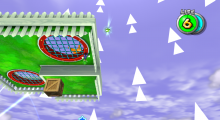
This Green Star is the worst one in the game, and the only example of cheap difficulty in the game.
But with that very notable exception, the Green Stars are a harmless addition that offers more content to the experience, without making the experience worse off because of it. As a reward for obtaining all of the 120 Green Stars, you unlock the final level of the game: The Grandmaster Galaxy. The Grandmaster Galaxy is very fitting of its name, being by far the most grueling level in the game. If you manage to beat it while also collecting the final Comet Medal of the game, you are still not done.
Yes, there is still one last challenge left in the game, the closing star of the game: The Perfect Run. The challenge starts with unlocking the level itself. There are two requirements to open The Perfect Run. The first one is to beat the Grandmaster Galaxy while also collecting the Comet Medal. The second requirement, however, is by far the worst part of the game. You need to have 9,999 Star Bits deposited in the Banktoad. Yes, 9,999 Star Bits. Not only is this a very high number, but this is made worse by the higher quota of the Hungry Lumas. If you had to do some grinding to feed the Hungry Lumas, then you need to do even more grinding to unlock The Perfect Run. The second requirement is nothing more than just a paywall that adds artificial difficulty to the game. Simply put, the 9,999 Star Bits requirement is unnecessary, and the game would be way better off without it. Without a doubt, the low point of the game.
So, with the grinding out of the way, we finally arrived at the level itself. Infamously considered the most strenuous level in not only Super Mario Galaxy 2, but also the entire Mario franchise, The Perfect Run tasks you with beating the Grandmaster Galaxy, with no checkpoints. While also having a modified level layout that makes it easier to die. And to make things worse, this is a Daredevil Comet, meaning that Mario dies in one hit. The Ultimate Challange was already a big challenge, so The Perfect Run is truly a level that only a few Super Mario Galaxy 2 players can hope to beat. And the satisfaction you get from accomplishing this feat is by far the most intrinsically rewarding experience in a Mario game to date. As a reward for your efforts, a particular returning character from the first game decides to visit the Starship Mario. Once again, the game fails to offer an extrinsically satisfying reward, but the intrinsic reward more than makes up for it. Making The Perfect Run, well, the perfect way to end this fantastic experience.
Finally, let's take a quick look at the game's boss battles. Super Mario Galaxy's boss battles were already the best in a 3D Mario game so far, so can Super Mario Galaxy 2 improve in that regard? Yes, it can. Super Mario Galaxy 2 offers unique new bosses as well as unique twists on previous concepts. By far, the highlights are the Bowser Jr. boss fights. Every single of them is unique, exhilarating, and a fun challenge to tackle. The other bosses are not that far off. All of them require a basic strategy and offer a better challenge than those of the first game. The Bowser fights, however, are a step down from the previous game. Due to Bowser's gigantic size, a confrontation such as the one from the first game is not possible. So instead, we need to avoid Bowser's attacks on a small planet while waiting for him to summon asteroids that Mario can use to deal damage. These fights might be a spectacle, but they are unquestionably easier than the first Galaxy game. The epic scope of the battles is so captivating that the anti-climatic easy difficulty can hurt these fights. The last confrontation, in particular, has by far the best boss battle music yet, which makes the low level of difficulty and strategy disappointing. While this is still better than Super Mario 64's terrible Bowser battles, Super Mario Galaxy still has the best Bowser fights yet. But regardless of Bowser's disappointing performance, Super Mario Galaxy 2's boss battles are easily among the best in the Mario franchise.
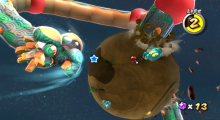

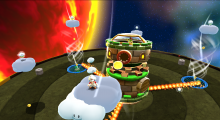

While the Bowser fights are worse than the first game, Super Mario Galaxy 2 gives us a fantastic group of boss battles.
Super Mario Galaxy 2 is a miracle of a game. Super Mario Galaxy was already one of those rare games that came as close as it possibly could to perfection. And somehow, Super Mario Galaxy 2 even managed to surpass even that. The amount of content and creativity offered here was indeed too much for a simple expansion to the first game. The improvements made to the core gameplay, the more energetic levels, the increased difficulty, and much more are remarkable achievements in their own right. But also think of the pressure the team must have faced when developing the game. They had to make a direct sequel to what was already one of the best games ever made. And to say that they succeeded would be an incredible understatement. Super Mario Galaxy 2 easily lives up to the first Super Mario Galaxy. And it is also, without a doubt, my favorite Mario game ever made. Very few games even come close to the amount of joy I get from playing this. The only bad things I can point out are a single Green Star and the 9,999 Star Bit paywall at the end. Which are insignificant compared to the overwhelming number of things that Super Mario Galaxy 2 does so well. Super Mario Galaxy 2 not only gets my vote for the best game in the Wii. Not only does it get my vote for the best game of the 7th generation. But it also gets my vote for the best Mario game ever made. Super Mario Galaxy 2 is easily a must-play that I wholeheartedly recommend to any Wii owner, any Mario fan, and any Nintendo fan, etc. Play it. You won't be disappointed.
Verdict
- Fantastic presentation.
- More challenging gameplay.
- Tight and memorable level design.
- Lots of content.
- High replayability.
- Fantastic Boss Fights.
- Unlocking the Perfect Run is unnecessarily time consuming.
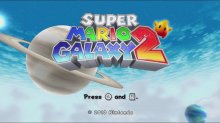
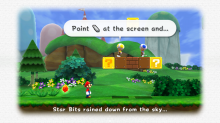
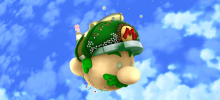
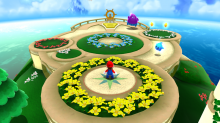
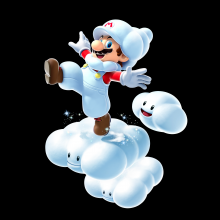

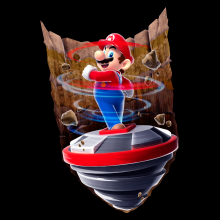
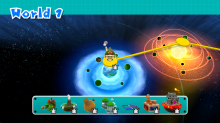
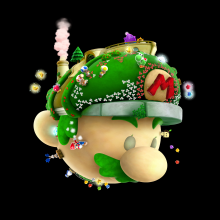

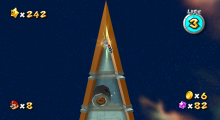
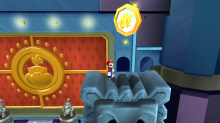
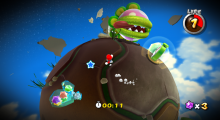
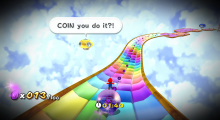
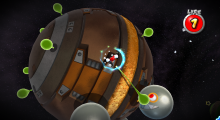
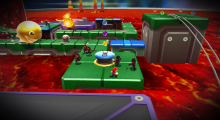

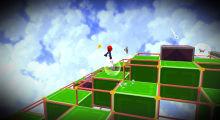

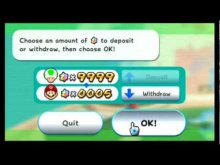
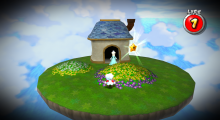
Reviews
MelGeek CYBER01 Magnetic Switch Rapid Trigger Gaming Keyboard
Today for review, we’ll be taking a look at the latest gaming keyboard from Meltek, the CYBER01 magnetic switch offering!
GEEKOM XT12 Pro Mini PC
Claimed to be the world's most cost-effecient i9 Mini PC, we check out the latest from Geekom.
Kospet Tank T3 Ultra
Tough enough to navigate and conquer the rugged wilderness.
Teenage Mutant Ninja Turtles Arcade: Wrath of the Mutants
The Turtles are back for their umpteenth game outing, but is this one worth it?
Alone in the Dark (2024)
Alone in the Dark is a Survival Horror game available for PlayStation 5, Xbox Series S/X and PC.
Site & Scene News
New Hot Discussed
DOOM has been ported to the retro game console in Persona 5 Royal
Review MelGeek CYBER01 Magnetic Switch Rapid Trigger Gaming Keyboard
Xbox release date for shooter 'Hypercharge: Unboxed' revealed
'Dragon Ball: Sparking! Zero' gets new trailer; revels new roster
PC and Xbox-exclusive 'Dungeons of Hinterberg' to launch in July
'Lost Records: Bloom & Rage' gets new trailer
'Promise Mascot Agency', the next game from 'Paradise Killer' developer, revealed
TheFloW releases new PPPwn kernel exploit for PS4, works on firmware 11.00
Delta emulator for iOS will support iPad devices in its next update
"Dino Crisis 2" for PC gets the "Classic Rebirth" mod treatment by developer Gemini
Wii U and 3DS online services shutting down today, but Pretendo is here to save the day
Nintendo Switch firmware update 18.0.1 has been released
The first retro emulator hits Apple's App Store, but you should probably avoid it
Delta emulator now available on the App Store for iOS
TheFloW releases new PPPwn kernel exploit for PS4, works on firmware 11.00
Nintendo takes down Gmod content from Steam's Workshop
A prototype of the original "The Legend of Zelda" for NES has been found and preserved
Anbernic reveals specs details of pocket-sized RG28XX retro handheld
Nintendo "Indie World" stream announced for April 17th, 2024
Nintendo Switch Online adds two more Nintendo 64 titles to its classic library
Wii U and 3DS online services shutting down today, but Pretendo is here to save the day
Nintendo takes down Gmod content from Steam's Workshop
The first retro emulator hits Apple's App Store, but you should probably avoid it
Delta emulator now available on the App Store for iOS
Nintendo Switch firmware update 18.0.1 has been released
TheFloW releases new PPPwn kernel exploit for PS4, works on firmware 11.00
DOOM has been ported to the retro game console in Persona 5 Royal
Nintendo Switch Online adds two more Nintendo 64 titles to its classic library
Nintendo "Indie World" stream announced for April 17th, 2024
The FCC has voted to restore net neutrality, reversing ruling from 2017